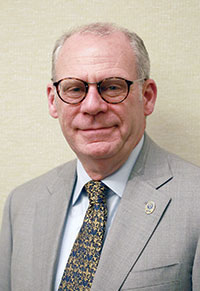
James Beck
James Beck, MD, ATSF, will serve as president of the ATS for the 2019-2020 term. He is professor of medicine in the Division of Pulmonary Sciences and Critical Care at the University of Colorado in Denver and vice chair for Veterans Affairs in the University of Colorado’s Department of Medicine. He is also chief of medicine for the VA Eastern Colorado Health Care System.
Dr. Beck shares his views about the Society’s new programs
and its growing role in helping members professionally
and in improving respiratory health worldwide.
Q: Why did you want to be ATS president, and what do you hope to achieve during your time as president?
A: I’ve wanted to become the ATS president for many years so that I could serve the membership of this outstanding society. I’ve been involved with ATS since I presented my first poster as a medical resident in 1987, and I’ve never missed an International Conference since then. It’s an honor to work with dedicated members on the Executive Committee, the Board of Directors, and our committees. During the coming year, we will focus on continuing our strategic planning, strengthening our relationships with other societies, developing our international activities, and assuring our sustainability.
I want to add that I wouldn’t have pursued this opportunity if the ATS didn’t have such a dedicated, professional, and enthusiastic staff. They are really amazing.
Q: You have championed the creation of more opportunities for clinician-educators within ATS. Why is it important to help this group, and why is the ATS the right organization to help?
A: Academic medicine is changing rapidly, and clinician-educators are one of the most rapidly growing groups in departments of medicine. Accordingly, there is an increasing need to provide skills-based instruction focused on how to be an outstanding educator, as well as on the scholarship of education. ATS is the right organization to lead this movement for pulmonary, critical care, and sleep. Our establishment of the Section on Medical Education gained immediate and enthusiastic acceptance, and it’s growing rapidly. We’ve also demonstrated our commitment to medical education by increasing programming at the International Conference.
Q: Are the Society’s efforts to launch a new journal later this year related to this effort?
A: Yes. The establishment of our new, open access journal, ATS Scholar, will provide a home for medical education research that will serve our members. We should all be proud of the existing three ATS journals, which are thriving and are of central importance to the ATS mission. It became apparent, however, that there are some constituencies in ATS whose activities did not fit into the existing journal structure or focus, such as medical education.
I’m incredibly proud that we are launching ATS Scholar to address these unmet needs. This is just one of many examples of ATS responsiveness to our members. I’d like to thank the Publications Policy Committee and ATS Chief of Journals Diane Gern for moving this journal from conception to reality so quickly.
Q: As an ATS leader, you have also encouraged younger members to get involved and become leaders. What is ATS doing in this area, and what more might be done?
A: The ATS is doing a remarkable job of bringing younger members into the Society and in making them feel welcome. I would point to our Resident Boot Camp, in which I have participated, and our Fellows Track Symposium as just two activities that demonstrate how welcoming we are to new members. For 2019, we’ve expanded these efforts to include a Fellows to Faculty Boot Camp. All of our assemblies have activities for junior members, as do many of our committees. For example, I’ve participated in the assembly mentorship program for years.
One of our challenges is to get the word out to our junior members and make sure they are aware of the many activities we offer.
Q: The ATS is unique among professional medical societies in integrating a patient perspective into virtually all of its activities through its Public Advisory Roundtable. How do the Society’s professional members benefit from having patients “at the table,” and can this relationship be enhanced?
A: I consider the Public Advisory Roundtable one of the key constituencies that contributes to current ATS success. The patient groups are incredibly important in helping us focus on the fact that we’re here to serve our patients as well as our membership. I’ve yet to meet an International Conference attendee who was not moved by a patient presentation during a session. PAR members are actively involved in all ATS planning, including having a seat on the Board of Directors. In fact, a considerable portion of our March board meeting focused on PAR and plans for the future.
Q: Nearly half of the attendees at ATS 2019 come from outside the U.S., and a third of the Society’s members are international. How can the ATS leverage its global reach to improve respiratory health around the world?
A: The ATS is a global society, and we value our international members, as well as our strong relationships with other international respiratory societies. ATS plans to evaluate our international activities during the coming year, including convening a task force to make recommendations. Of course, we will solicit input from our International Health Committee and other ATS groups.
There is a great need for international advocacy work, and we are already cooperating well with other groups to achieve these goals. Additionally, ATS continues to lead in training individuals in research in developing countries through our successful MECOR [Methods in Epidemiologic, Clinical and Operations Research] Program. I’m looking forward to strengthening these international relationships during the coming year.
